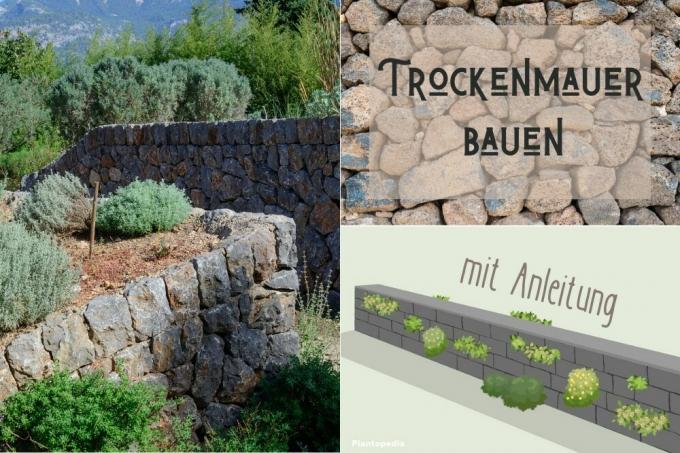
table of contents
- Rationale
- materials
- Instructions for building
- frequently asked Questions
A dry stone wall can be used to support slopes in the garden or to delimit certain sections. Building such a wall is relatively easy. We explain how to do it step by step.
In a nutshell
- With a dry stone wall, the stones lie dry, i.e. without mortar, on top of one another
- The joints are also not grouted afterwards
- This creates shelter for insects and small animals
- The wall structure can even be planted
- A garden design that is as ecological as it is visually appealing is possible
Rationale
Usually the stones of walls are connected to one another with a mortar. The mortar acts like a kind of glue that fixes the individual stones and sticks them together. The stability of such constructions is astonishing. Just think of house walls that, despite being relatively high, not only do not collapse, but support the whole house as a skeleton. However, it is also possible to build relatively stable walls without any mortar. One then speaks of a so-called dry stone wall - precisely because there is no moist binding resp. Adhesive is used, but the stones are layered "dry" on top of each other. These types of walls are now enjoying particular popularity in our gardens. They are used there in a variety of ways, for example as:

- Retaining walls for slopes and embankments,
- Fencing for certain garden areas,
- Design features of a natural stone garden,
- Separation element against unsightly garden parts (compost),
- Mounts from Raised beds,
- and support elements for terraces.
The construction of dry stone walls is relatively easy. It can also be done by laypeople without great manual experience. However, patience and a lot of tinkering are required.
Note: The great art of drywall construction with stones is to place the individual stones on top of one another so that a stable wall can be created. Since mostly uneven natural stones are used, this cannot be done without constant trial and error.
materials
In order to be able to erect a dry stone wall, not much material or Equipment. The following short list essentially includes everything that is needed in terms of building materials and tools:
- Natural stones
- fine gravel or Construction sand
- Spirit level
- Tamper
- Shovel or spade
- Rubber mallet
- line
- four wooden sticks to attach the cord
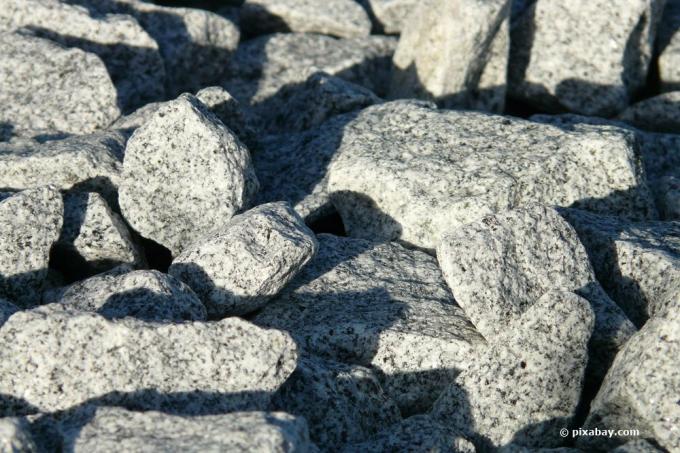
The central elements of every drywall construction for the garden are of course the natural stones. These are untreated or uncut stones in different shapes and sizes - stones as they can also be found in nature. Since it would usually be very time-consuming to gather them together in fields, we recommend going to the gardening market or the hardware store. There the stones can be ordered in different versions. Usually they are then delivered to you directly.
Tip: When choosing the stones, you should make sure that they match the rest of the design of the garden. Only then does a really harmonious, coherent picture emerge.
Instructions for building
The instructions follow the graphic step by step. It serves as a guide as to which work has to be done and when in order to achieve a stable result. However, the graphic can only provide a schematic representation and therefore does not take into account how the individual stones have to be layered on top of each other.
Lay the foundation
A foundation is essential so that the dry stone wall can later be as stable as possible. In the first step, you therefore mark the dimensions of the foundation with the help of a piece of string. The surface of the foundation should protrude over the future wall base on all four sides by at least five centimeters. The foundation must therefore be wider than the base of the wall. Mark out a rectangle with the string. The four wooden sticks are used to attach the cord. It is best to use a spirit level to align the line.
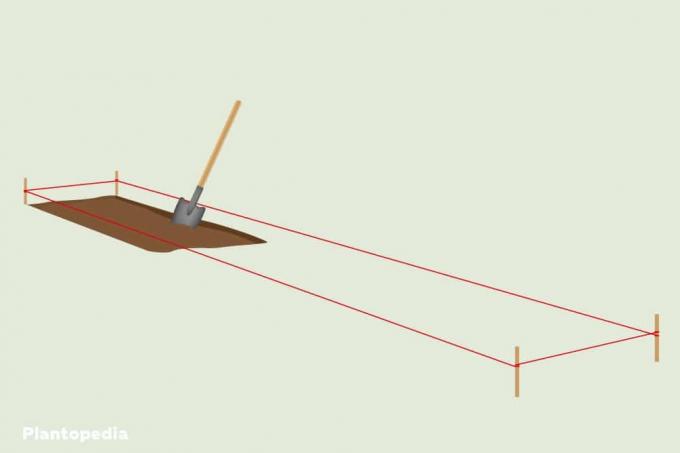
In the next step, the foundation is then excavated. To do this, the floor area within the line boundary is gouged out to a depth of around 40 centimeters with a spade or shovel. It is built as a small trench. This trench is then filled with fine gravel or construction sand up to a height of 30 centimeters. Then you have to remove the gravel or compact the sand well with a tamper, which you can borrow from any hardware store. The foundation for the drywall has thus been laid.
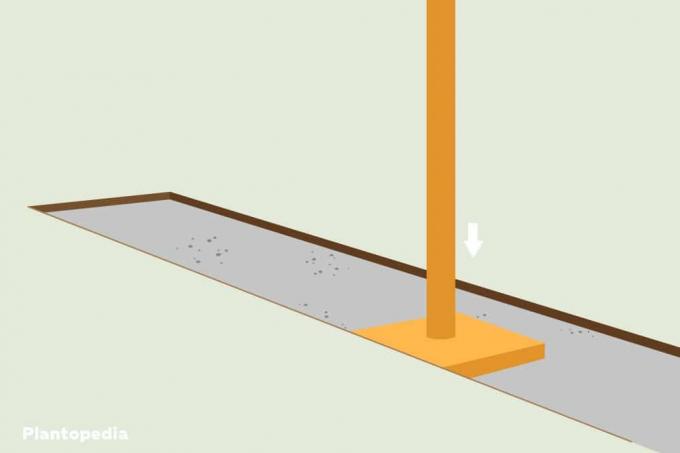
Lay the first row of stones
The first row of stones, lying directly on the foundation, is something like the base of the entire wall. Therefore, you should proceed very carefully when laying the stones. The stones are lined up in such a way that the joints between them are as small as possible. Ideally, it should be laid in the middle of the foundation. So there is always some space left on the sides. Usually several attempts or Try to find exactly the stones that go well with each other. It is advisable to press the stones firmly into the ground or to knock them down with a rubber mallet. When you have finished the first row, fill in the sides with the soil you dug earlier. Here it also makes sense to compact the earth. In addition, the filling should protrude a few centimeters above the soil surface.
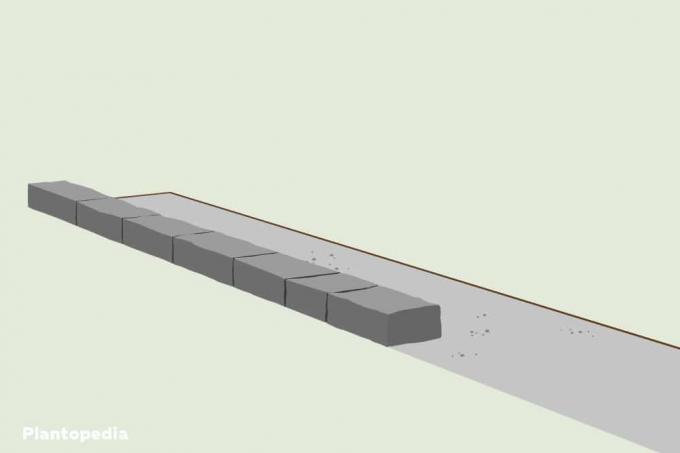
Finish building the wall
As already mentioned, building a drywall usually doesn't work without tinkering and trying out. It is quite simply important that the differently shaped stones match each other as well as possible. You should therefore take your time when layering the stones and also bring a little patience. When building, it is important that the individual stones lie firmly on the ground and do not wobble. In addition, it is essential to observe something like a golden rule when building a wall: The stones must always be stacked on top of each other. Under no circumstances should a continuous joint be created from bottom to top. We recommend that you should not build the drywall higher than one meter, otherwise there could be problems with the statics. Once you have laid the last row of stones, you can still place cover plates on it. However, there is usually no avoiding fixation with mortar.
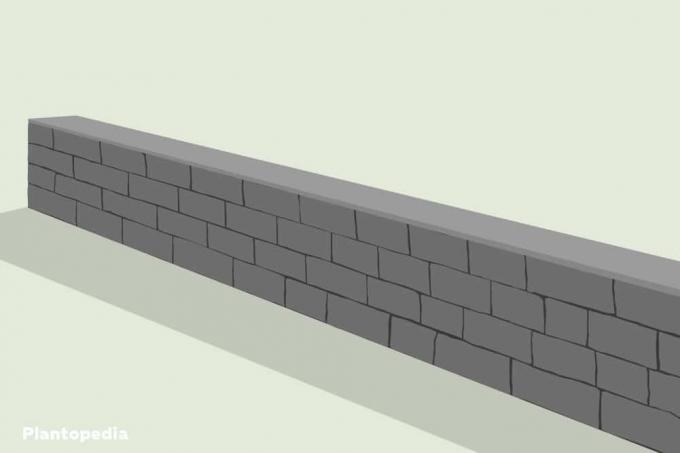
Plant the wall
The construction of the dry stone wall is, so to speak, the first part of the work, the design after construction is the second part. Because: If you like, you can also plant the dry stone wall afterwards. To do this, a mixture of soil and humus is spread over parts of the joints. You should water the mixture well immediately. You can then insert smaller plants or seeds into this plant substrate. It is important that the selected plants require as little water as possible in order to grow and thrive. Depending on the location, they should also be able to cope with the sun and warmth. Incidentally, manual planting does not have to be. Sooner or later, various plants will automatically grow in the joints.
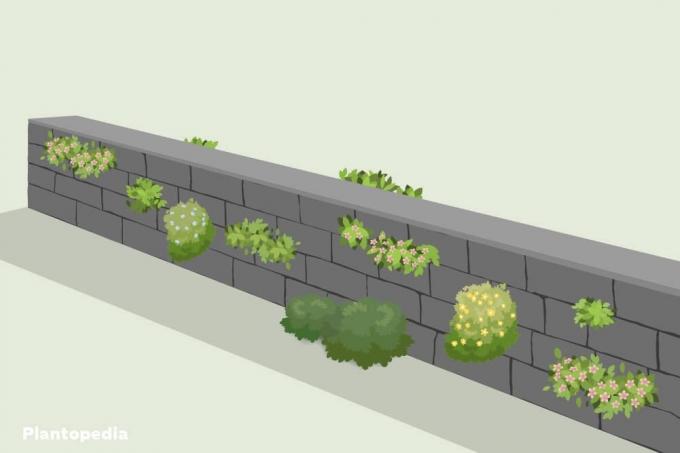
frequently asked Questions
The joints and cracks in dry stone walls are perfect places of retreat and settlement for a multitude of animals. Especially insects from bumblebees to spiders will hide in it. You can therefore compare the wall with an insect hotel. Since the stones heat up relatively strongly from the sun and also store this heat well, the construction will also become a home for lizards and slow worms.
Since the joints between the stones are not filled, the wind can inevitably bring in crumbs of earth and humus. Over time, this more or less inevitably develops a subsoil that can be used by certain plants. The natural flight of seeds then ensures that plants grow there. Which plants will grow in and out of the joints depends on the surrounding flora.
No. As a rule, natural stones look better and appear more natural in a garden. Natural stones also have the advantage that they can be better misunderstood into one another. Regardless of this, standardized stones or stones have long been used in hardware stores and garden centers. Stone elements available that are suitable for a sturdy wall. If you want to work with these materials, you can also use the above instructions and the graphic as a guide.



